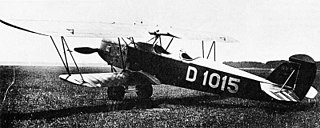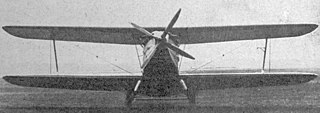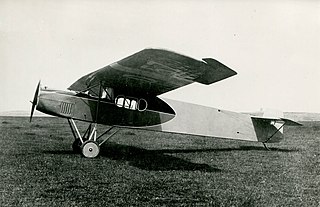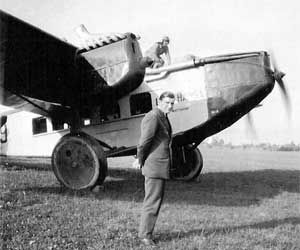
The Dornier Do 18 was a development of the Do 16 flying boat. It was developed for the Luftwaffe, but Deutsche Luft Hansa received five aircraft and used these for tests between the Azores and the North American continent in 1936 and on their mail route over the South Atlantic from 1937 to 1939.

The Junkers G 24 was a German three-engine, all-metal low-wing monoplane passenger aircraft manufactured by Junkers from 1925. Junkers F 24 was the designation for single-engine versions of the same aircraft.
The Albatros L 58 was a German airliner of the 1920s. It was a single-engine cantilever monoplane which accommodated the pilot in an open cockpit at the top of the fuselage, and seated five-six passengers within it.

The Albatros L 75 Ass was a German trainer biplane of the 1920s. Of conventional configuration, it seated the pilot and instructor in separate, open cockpits. The wings were single-bay, equal-span, and had a slight stagger. Production continued after Albatros was absorbed by Focke-Wulf.

The Arado SC I was a biplane trainer developed in Germany in the 1920s. It was based on the S I, but powered by a far more powerful inline engine. Accordingly, the structure received considerable strengthening. The aircraft was intended for the clandestine military flying school at Lipetsk, but it was not accepted for this service. Instead, a small number were built for the Deutsche Verkehrsfliegerschule.
The Arado SC II was a biplane trainer designed and produced by the German aircraft manufacturer Arado.
The Arado V.1 was a prototype airliner, built in Germany in 1927. It was a single-engine, high-wing braced monoplane with tailwheel undercarriage. It made several long-distance flights, including carrying mail to South America, before being exhibited in Berlin in 1929, when it was bought by Deutsche Luft Hansa.

The Caspar C 35 Priwall was a German airliner of the late 1920s, of which only a single example was built. It was a large, single-engine, single-bay biplane of conventional configuration with fixed tailskid undercarriage. The staggered, equal-span wings were braced with a large I-strut. Not only were the passengers seated within a fully enclosed cabin, but the flight deck was fully enclosed as well.

The Caudron C.440 Goéland ("seagull") was a six-seat twin-engine utility aircraft developed in France in the mid-1930s.

The BFW M.20 was a German single-engine, high-wing monoplane ten-seat passenger transport aircraft, developed in the late 1920s and early 1930s. Deutsche Luft Hansa used it throughout the 1930s on a variety of routes.

The DFW C.IV, DFW C.V, DFW C.VI, and DFW F37 were a family of German reconnaissance aircraft first used in 1916 in World War I. They were conventionally configured biplanes with unequal-span unstaggered wings and seating for the pilot and observer in tandem, open cockpits. Like the DFW C.II before them, these aircraft seated the gunner to the rear and armed him with a machine gun on a ring mount. Compared to preceding B- and C-class designs by DFW, however, the aerodynamics of the fuselage were more refined, and when coupled with more powerful engines, resulted in a machine with excellent performance.

The Fokker F.III was a single-engined high-winged monoplane aircraft produced in the 1920s by the Dutch aircraft manufacturer Fokker. It could carry five passengers. The aircraft was also built under licence in Germany as the Fokker-Grulich F.III.

The Focke-Wulf A 17 Möwe was an airliner designed and produced by the German aircraft manufacturer Focke-Wulf. It was the company's first large commercial aircraft.

The Fokker F.II was the first of a long series of commercial aircraft from the Fokker Aircraft Company, flying in 1919. In a biplane age, it presented a distinct clean, high-wing monoplane style that sold successfully across Europe and North America during the development of commercial passenger-carrying aviation.

The Rohrbach Ro X Romar was a German long-range commercial flying-boat and the last aircraft designed and built by Rohrbach Metall Flugzeugbau GmbH.

The Heinkel HD 39 was a special-purpose cargo aircraft developed in Germany in the 1920s to distribute the Berlin newspaper B.Z.. It was a conventional single-bay biplane with staggered wings of equal span, and a fuselage that nearly filled the interplane gap. The pilot sat in an open cockpit, and the undercarriage was of fixed, tailskid type with divided main units. The sole example of the type was built after Ernst Heinkel found out, by chance, that B.Z. required such an aircraft and had ordered two machines from Albatros. Heinkel convinced publisher Ullstein-Verlag to purchase a third aircraft from his firm.

The LVG C.II was a 1910s German two-seat reconnaissance biplane designed at the Luft-Verkehrs-Gesellschaft for the Luftstreitkräfte.
The Messerschmitt M 24, otherwise known as the BFW M.24, was an airliner developed in Germany in the late 1920s as a further development in the series of designs produced by Messerschmitt, based on the M 18. Like the M 18 and its follow-on, the M 20, it was a high-wing cantilever monoplane with a fully enclosed cabin and fixed tailwheel undercarriage. It was slightly smaller than the M 20, seating only eight passengers instead of the ten that could be carried by the previous aircraft.
The Messerschmitt M 28 was a mail plane developed in Germany in the early 1930s to meet a requirement by Deutsche Luft Hansa. It was a single-engine, low-wing cantilever monoplane of conventional design with an enclosed cockpit and fixed, tailskid undercarriage.

The Rohrbach Ro VIII Roland was an semi-cantilever monoplane trimotor airliner designed and produced by the German aircraft manufacturer Rohrbach. It was capable of unrivalled performance in some categories; during its early years, the type held no less than 22 world records.
















